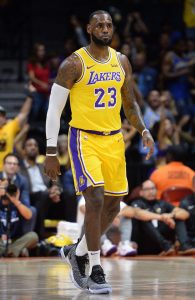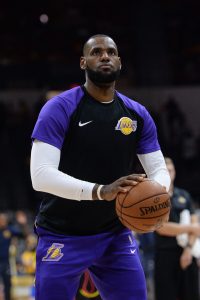Hoops Rumors is breaking down the 2018 offseason for all 30 NBA teams, revisiting the summer’s free agent signings, trades, draft picks, departures, and more. We’ll evaluate each team’s moves from the last several months and look ahead to what the 2018/19 season holds for all 30 franchises. Today, we’re focusing on the Los Angeles Lakers.
Signings:
 Standard contracts:
Standard contracts:
- LeBron James: Four years, maximum salary ($153.31MM). Fourth-year player option. Signed using cap room.
- Kentavious Caldwell-Pope: One year, $12MM. Signed using cap room.
- Rajon Rondo: One year, $9MM. Signed using cap room.
- Lance Stephenson: One year, $4.45MM. Signed using cap room.
- Michael Beasley: One year, $3.5MM. Signed using room exception.
- JaVale McGee: One year, minimum salary. Signed using minimum salary exception.
- Two-way contracts:
- Travis Wear
- Note: Malik Newman signed a two-way contract with the Lakers, but was later waived.
- Non-guaranteed camp contracts:
- Joel Berry: One year, minimum salary.
- Jeffrey Carroll: One year, minimum salary.
- Johnathan Williams: One year, minimum salary.
Trades:
- Acquired the draft rights to Isaac Bonga (No. 39 pick) from the Sixers in exchange for the Bulls’ 2019 second-round pick and cash ($1.5MM).
Draft picks:
- 1-25: Moritz Wagner — Signed to rookie contract.
- 2-39: Isaac Bonga — Signed to three-year, $4.08MM contract. First two years guaranteed. Signed using cap room.
- 2-47: Sviatoslav Mykhailiuk — Signed to three-year, $4.57MM contract. First year guaranteed. Third-year team option. Signed using cap room.
Departing players:
- Thomas Bryant (waived)
- Luol Deng (bought out)
- Tyler Ennis (waived)
- Channing Frye
- Andre Ingram
- Brook Lopez
- Gary Payton II (two-way)
- Julius Randle
- Isaiah Thomas
Other offseason news:
- Hired Kurt Rambis as senior basketball advisor.
Salary cap situation:
- Used cap space; now over the cap.
- Carrying approximately $102.8MM in guaranteed salaries.
- $949K of room exception still available ($3.5MM used on Michael Beasley).
Check out the Los Angeles Lakers’ full roster and depth chart at RosterResource.com.
Story of the summer:
Only two years after the Lakers’ old management group missed out on its top free agent targets and handed out massive four-year contracts to Timofey Mozgov and Luol Deng, the new-look front office led by Magic Johnson and Rob Pelinka landed arguably the biggest free agent in franchise history.
It’s worth acknowledging that Johnson and Pelinka had a major head start in their recruiting efforts — the opportunity to live in Los Angeles and to play for an iconic franchise were significant factors in LeBron James‘ decision to join the Lakers. Still, LeBron’s move to L.A. wasn’t considered a fait accompli leading up to July 1, and the club’s front office deserves credit for putting together a situation and a roster that appealed to the NBA’s best player.
If the Lakers didn’t have a young core made of promising youngsters like Lonzo Ball, Brandon Ingram, Kyle Kuzma, and Josh Hart, L.A. almost certainly wouldn’t have been as attractive a destination to James. The same can be said for the Lakers’ cap flexibility, which puts the team in a great position to lure another star to Los Angeles within the next year or two.
By securing a commitment from James on the first day of 2018’s free agent period, the Lakers ensured they’d be among the biggest winners of the NBA offseason, and set the organization on a fascinating new path for the next several years. Now, it’s just a matter of figuring out how best to fill out the roster around LeBron and return to legit title contention.
Key offseason losses:
The Lakers didn’t have to renounce Julius Randle in order to create the cap room to sign James. Having already agreed to deals with LeBron and Kentavious Caldwell-Pope, the club was in position to retain Randle’s cap hold and go over the cap – if necessary – to sign him to a new deal.
However, Johnson and Pelinka apparently determined that Randle wasn’t a long-term building block, renouncing his rights and making him an unrestricted free agent — he quickly agreed to sign with the Pelicans. It will be interesting to see if the Lakers’ front office come to regret that decision. Randle, who is still just 23 years old, enjoyed his best NBA season in 2017/18, averaging 18.6 PPG, 9.1 RPG, and 3.1 APG after entering the starting lineup in late December.
The loss of Brook Lopez also raised some eyebrows. Like Randle, Lopez didn’t exactly score a massive payday with his new team. The Lakers could’ve easily outbid the Bucks for the veteran center, but opted not to, and will enter the season with JaVale McGee, Ivica Zubac, and Moritz Wagner atop their depth chart at the five. Lopez is no longer the player he once was, but he still provides some rim protection, low-post scoring, and even an improving outside shot. He may well be missed in certain situations.
Outside of those two frontcourt players, none of the Lakers departing players should leave a major hole in the club’s lineup. Isaiah Thomas, Channing Frye, and Deng have all been key pieces for teams in the past, but didn’t do much for the Lakers last season.
It’s worth noting that Thomas Bryant was one of just two players who was claimed off waivers this offseason. Bryant, a second-round pick in 2017, was unlikely to develop into a starter for the Lakers, but he’s still viewed favorably enough that the in-the-tax Wizards were willing to guarantee his salary after L.A. cut him.
Key offseason additions:
No player who changed teams in the offseason figures to have a bigger impact than James. Even at age 33, he’s coming off one of his very best NBA seasons and continues to show no signs of wearing down — incredibly, he played all 82 games last year for the first time in his 15-year career.
Beyond James, many of the Lakers’ other additions this summer were more divisive. Caldwell-Pope is a solid player, but in a buyers’ market, his $12MM price tag looks a little steep. It’s fair to question whether he would have received the same deal from L.A. if he didn’t share an agent with LeBron (call it the Tristan Thompson corollary).
At $9MM, Rajon Rondo looks like a solid value, though it remains to be seen how he’ll mesh with Ball, since both players have strong cases to be the starting point guard. The cap space used to sign Rondo was also created by renouncing Randle, so if the young big man thrives after leaving L.A., that move will be second-guessed, even if Rondo has a solid year.
The Lakers’ more surprising signings were low-cost additions that don’t come with a ton of risk. Lance Stephenson, McGee, and Michael Beasley all signed one-year contracts ranging from $1.5-4.5MM. The Lakers may be trying their luck with the basketball gods by packing their roster with such strong personalities, but as long as Luke Walton can manage the locker room, there’s a lot of on-court potential here, with athleticism and play-making ability galore.
Finally, the Lakers continued to add to their young core by drafting Wagner, Isaac Bonga (the NBA’s youngest player), and Sviatoslav Mykhailiuk, who is viewed as an early dark horse to become one of the steals of the 2018 draft.
Outlook for 2018/19:
If his early days in Miami and Cleveland (the second time around) are any indication, James and his new team will require a transition period to work out the kinks. Unlike LeBron’s old teams though, the Lakers will face incredibly tough competition within their conference and aren’t necessarily assured of a playoff berth, let alone a spot in the Finals.
If James had signed a short-term deal that featured a 2019 opt-out, that uncertainty would be more concerning, but the Lakers can afford to be patient to some extent, given LeBron’s long-term commitment to the franchise. There’s no pressure to win a title in year one.
Of course, it would still be a disappointment if the Lakers don’t win a postseason series or two, or if they miss the playoffs altogether. But the top priorities for the team this season will be continuing to develop the young core, identifying which players can and can’t thrive alongside LeBron, and positioning themselves for another big splash in free agency or on the trade market. For the time being, after finally experiencing some free agent success this summer, the Lakers remain in the honeymoon period.
Salary information from Basketball Insiders was used in the creation of this post. Photos courtesy of USA Today Sports Images.
6th seed. And once in the playoffs they will be interesting.
Reports about Julius Randle was that they met with him and he basically told them he preferred going to a different team to returning. They granted him his request to be unrestricted. Not *quite* that they just decided they didn’t want him. More that they were honoring him by granting his request.
I didn’t say they didn’t want him. But if they viewed him as a legit long-term piece, they wouldn’t have just let him go when he asked. If if were that easy, a lot more restricted free agents would take that path.
I just don’t see why so many people think the Lakers are going to be THAT improved. The Lakers young players will undoubtedly take a step back because LeBron likes his vets. Rondo starting over Ball is proof of that. LeBron would have to be worth +15 to a team and I don’t think he can, especially in the West, and that is what the Lakers need to even make the playoffs. I’m just getting a “Jordan on the Wizards” feeling here.